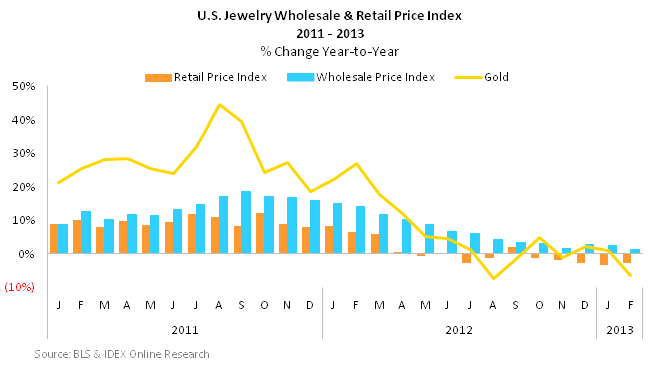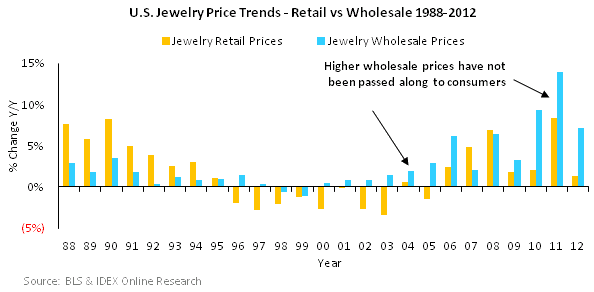Let’s start with the bottom line – U.S. retailers need to pay more for the jewelry they are selling, and don’t get that much more when selling it.The wholesale prices they are paying are rising at a higher rate than the retail prices they are charging. It’s a margin squeeze. It’s a situation that diamond manufacturers know very well; they too are suffering from margin squeeze – paying more for rough diamonds and not getting that much more for the polished diamonds.
There are a few other similarities, high overhead costs, for example. A store in a prime location with good visibility and traffic costs money. Financing costs are not any easier either. The cost of doing business in either sector of the diamond pipeline – manufacturing and retailing – is high.
As gold and diamond prices increased almost wildly in 2011, wholesale prices soared to keep up with the cost of components. Retail prices followed, but at a slower rate, with retailers absorbing some of the price shockwaves.

Some will say that retailers, those with wider margins, can absorb the price fluctuations far more than the narrow low-single digit margin manufacturers. Perhaps, some might say, it is the role of retailers to bite the bullet, moderating prices to fit consumers’ palate.
However, as everyone in the industry knows, consumers are in many ways setting prices. This is a truth that retailers know so well – price points are sensitive and they want jewelry items that fit into specific price point “drawers.” If the price of a component rises, its share in the final product must be reduced. Higher gold prices have resulted in lighter jewelry. Rising diamond prices have pushed retailers to pick lower color or clarity goods.
When gold and diamond prices relaxed in 2012, wholesale prices declined with them as the graph above shows. However, retail prices were subdued at best – retailers continued to absorb rising wholesale prices. In fact, since October 2012, retail prices have been declining even though suppliers have continued to increase their prices.
The 21st Century curse
The point to note is that this is not a temporary situation. Since the turn of the current century, retailers have been paying more and are being paid less. Every year since the year 2000, wholesale prices have increased and in 10 of the 12 past years, retail prices have lagged behind. The two exceptions were in 2007 and 2008, the “Happy Years” of rising discretionary income before the Great Recession.
During that time, diamonds and gold just couldn’t catch up and retailers had a window of opportunity to increase margins. That window has closed.

The dynamics of the past few years are glaringly clear. As Ken Gassman details in his analysis this week, jewelry suppliers’ wholesale prices were up by 1.3% year-over-year in February, while retail prices declined 0.9%. The trend is continuing.
Since the price of gold has softened (and diamond prices have remained largely unchanged) over the past six months, why are manufacturers still pushing up prices?
First, because they must try. This is a basic tenet of economic behavior; always try to increase your margins, either by saving on costs or by increasing income. But also because manufacturers, and this is very obvious among diamond polishers, have very little breathing room. With a profit margin of 3%-4% (the CEO of a very large Sightholder recently told me he would love to have those margins), they too need a window of opportunity.
A way out?
In such a scenario, no wonder that the entire diamond pipeline is praying for growing demand and a shrinking supply of diamonds. If this scenario materializes, margins will grow some. No one wants to hear about it not happening.
In practical terms, where everyone is already down to minimal costs and with hardly any more areas to cut further, the only two places where some relief may come is at the bookends – mining and retail. Diamond miners may decrease prices, but this is an unlikely scenario. De Beers is already shrinking and Anglo American wants to see a return on its $5.2 billion investment. Alrosa is priming itself for an IPO and needs to show nice returns to be attractive.
This means consumers must be persuaded to pay more for diamonds and this can only be done with branding and marketing, not by selling price points. The road to that goal seems long and rough, but what other means exist to generate decent returns?

